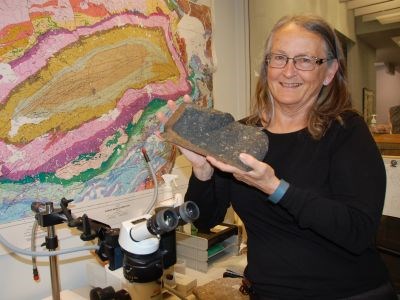Laughter erupts from Ruth Debicki of the Ontario Geological Survey (OGS) when asked if her brush with space exploration royalty in the early 1970s stands out as a career highlight.
“We do lots of interesting stuff and we meet lots of interesting people,” replied Debicki, the OGS’s land use policy and planning coordinator based in Sudbury. “In the OGS’s 125 years of history, this was one day out of 45,000.”
Back in the spring of 1972, Debicki was a junior staffer in the small resident geologist office in Sudbury when her boss, Ken Card, fielded a call from NASA.
The three-man crew of Apollo 17 — Gene Cernan, Ron Evans and Harrison Schmitt — were arriving in Sudbury, May 24-25, for geological training.
“The boss said, we’ve got to go take the astronauts out on this date,” recalled Debicki. “It was a surprise, but you never know what’s going to happen.”
The Apollo astronauts were, and still remain, almost immortal figures, but she wasn’t particularly star-struck; just another day on the job.
“No, I was happy to be able to share the unique geoscience that we have in Sudbury.”
The year before, in June 1971, NASA dispatched the Apollo 16 astronauts to Sudbury for field training, but they worked exclusively with the geologists from Inco.
When NASA decided that Apollo 17 would be the sixth and last mission to the moon, Harrison Schmitt, who was also a geologist, was bumped up in the crew assignments.
“The idea was the astronauts were going to the moon to look at meteorite impacts,” said Debicki. “But they needed to know what meteorite impact features looked like so they can recognize them when they see them.”
The crew’s first day in Sudbury was spent doing aerial flyovers of the basin and Lake Wanapitae — itself an impact crater — before Debicki and Card joined them for the second day.
With backpacks and sampling tools in hand, the group went hiking the rocky hills around Onaping, on the north end of the basin, observing shatter cones and breccia formations formed from the meteorite that struck Earth at the site of Sudbury, some 1.85 billion years ago.
Debicki remembers the late 1960s and early 1970s being a “transformational time” in the field of geoscience. Prominent geophysicists like John Tuzo Wilson and Robert Dietz were advancing groundbreaking theories on plate tectonics and impact craters.
“The idea of Sudbury being a meteor impact (site) did not gain immediate acceptance,” said Debicki, though all the physical signs on the terrain were there. The prevailing thought was the mineral riches came from volcanic activity, largely because of the pyroclastic-type rock found in the area.
All the arguments and evidence for and against the impact concept were presented at special symposium of the Geological Association of Canada’s convention in Sudbury in May 1971.
Among the revelations being debated was the contention by Dietz that the impact sites he visited around the world all contained these rare and distinctive conical features called shatter cones — a stressed rock indicating that some cataclysmic event had occurred.
Sure enough, there were shatter cones, of all sizes, all over Sudbury, including an outcropping on Ramsey Lake Road.
“We had seen them and thought it was a strange rock,” said Debicki.
The timing of the arrival of the Apollo crews coincided with this new interpretation of the basin. The OGS were only too happy to share their findings with their enthusiastic visitors, especially Schmitt.
“We were showing them shatter cones and the Onaping fall-back breccia. We spent time at High Falls showing them Sudbury breccia, all the stuff that didn’t blow up (during the meteorite strike) but broke apart in the target rock.
“I remember Harrison Schmitt coming down over a hill and he had a huge boulder in his arms. It was a rock like none that he had ever seen before, and he was all excited about it because he wondered what the link of that was to the impact features.”
The media had no understanding of geoscience so the visit to Sudbury — and its blackened moonscape from a century of smelting — was portrayed as training the astronauts for the type of desolate environment they would encounter on the moon, a myth that’s still reported today.
“The city’s been living it down for decades,” said Debicki, even though the Apollo crew visited other impact sites like the Barringer Crater in Arizona.
Spending a day with the astronauts was one of her many memorable encounters with famous people, including Prince Charles and Lady Diana, Sir Edmund Hillary, Robert Ballard and many significant names in geoscience, including John Tuzo Wilson.
Since those early days of space exploration, the OGS Sudbury office has had no contact with NASA, but Debicki’s colleagues in Timmins did work with the space agency in the run-up to the Mars missions.
The first rocks analyzed by the Martian rover in 2011 were dubbed by NASA as Tisdale 1, named after the South Porcupine township, to acknowledge their relationship with the Timmins OGS staff, she said.
“If they were to do more research, I would expect them to engage with us again.”




